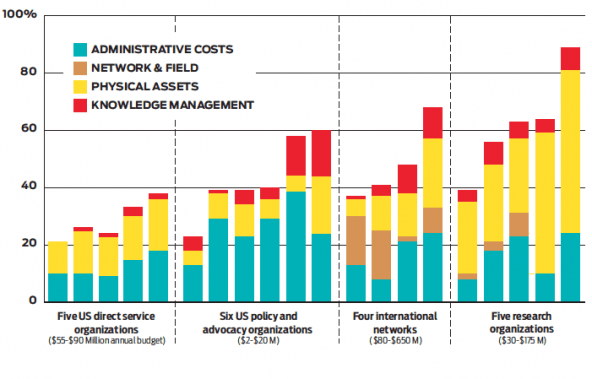The nonprofit overhead debate rages on as organizations and their rating agencies take a closer look at what it means to be an effective nonprofit.
In 2013, three major agencies that evaluate and serve the nonprofit industry co-authored an open letter to the American donor. GuideStar, Charity Navigator, and the BBB Giving Alliance wanted to address "the false conception that financial ratios are the sole indicator of nonprofit performance".
This letter, titled "The Overhead Myth", called for a change in the way nonprofit effectiveness was evaluated. The authors contend that over-reliance on this rigid formula as a one-size-fits-all determinant for effectiveness leads many otherwise successful nonprofits to face unwarranted scrutiny.
In certain instances — such as the Wounded Warrior Project debacle — the scrutiny is well-deserved. Instead of serving veterans, a New York Times investigation discovered that the organization was essentially paying itself first before it allotted funds to serve its constituents.
Surely, this is not what the donors had in mind when they gave to the organization. Donors have a reasonable expectation that their generosity will directly fund the nonprofit's mission, rather than bankroll outrageous executive salaries and luxurious trips around the world.
The problem arises when organizations attempt to over-correct whittling down their nonprofit overhead in order to avoid the merest hint of fiscal misdeed.
To that end, many nonprofits set a goal of allocating 85% of revenue to mission-based expenses and minimizing operational costs to 15% or less.
The Nonprofit Overhead Disconnect
However, according to Guidestar president and CEO Jacob Harold, this is a misguided effort. In a recent interview, he pointed out that short-sighted organizations, nonprofit or otherwise, which narrowly focus on reducing expenditures as much as possible for the sake of appearances and public opinion often run the risk of underinvesting in their own resources and infrastructure.
This phenomenon, dubbed "the nonprofit starvation cycle" in a report by research by the Urban Institute's National Center for Charitable Statistics and Center on Philanthropy at Indiana University, has the potential to undermine any nonprofit's good works, simply by rendering it unable to fully realize its potential due to underfunding.
For instance, lower salaries and fewer employee benefits at nonprofit organizations tend to lead to much higher turnover rates, which impedes the nonprofit's ability to attract and retain talented, high-quality staff. Even turnover itself is expensive, causing nonprofits to spend time and money locating, hiring, and training staff, only to lose them not long afterward.
A recent report by The Bridgespan Group confirms this theory— with some surprising additional data.
They evaluated 20 well-known, high-performing nonprofits to determine their actual nonprofit overhead, those indirect costs which are not attributed to a specific program or service.
What they found was that the median indirect cost rate for all nonprofits was over 40%, nearly three times the 15% overhead rate that most foundations provide.

Bridgespan separated the 20 nonprofits it examined into four distinct categories: U.S.-based direct service, policy and advocacy organizations, international networks, and research organizations. As you can see, nonprofits studied have expenses and needs that are vastly different from others, even within their own loosely defined sector.
For example, a local nonprofit that focuses on after-school reading enrichment programs has fewer indirect nonprofit overhead costs than, say, a nationwide wildlife protection agency with multiple offices and hundreds of employees.
None of this is news to businesses within for-profit industries, where overhead spending in the form of indirect costs is viewed as acceptable.
These costs routinely top 40% or more of total revenue — and for companies in the IT sector, the percentages are even greater. As the report notes,
Among firms in the S&P 500, for example, consumer staple companies have a median indirect cost rate of 34 percent, whereas information technology companies reach 78 percent.
These necessary expenditures are often referred to as “reinvestment costs” and research shows that investors understand and acknowledge their importance.
FastCompany Co.Exist adds, "In the commercial world, investors have come to expect that companies in different spaces require different overhead. There is no boilerplate expense sheet. That’s a lesson nonprofit funders have failed to learn."
A Better Way to Look at Nonprofit Overhead
The reason many nonprofits struggle with overhead more than for-profit companies is because many donors are only willing to give to the cause, not the organization. That is to say, they are happy to make a donation to purchase backpacks for schoolchildren, but are more reticent when it comes to helping the backpack charity keep their lights on.
To bridge this disconnect, The Bridgespan Group proposes a "Pay-What-It-Takes" approach to philanthropy. It's a fairly simple premise: executives at each nonprofit must calculate an acceptable range for their individual organization, communicate this information clearly and honestly with donors, and fulfill these financial obligations promptly.
Nonprofits also need to help donors connect to the overarching mission, rather than an individual campaign, which might be limited in time or scope. In this way, donors can get a better sense of how the nonprofit spends their pledges and gifts, ensuring they will be able to trust that they will use their fundraising revenue wisely in the future.






